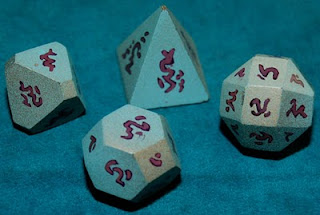These are wonderful props because, although there were hundreds of Vulcan costumes created for Star Trek over the years, there were very few Vulcan props. These were also handled by the father of all Vulcans, Spock (Leonard Nimoy). In "Unification, Part II" a young Romulan named D'Tan (Vidal Peterson) brings these dice to Spock. He tells Spock that they were his toys as a child and Spock tells him that they are very old and that the symbols form the syllabic nucleus of the Vulcan language.
The description of the symbols as being "syllabic" is in line with what little else we know about the Vulcan language. It suggests that each symbol represents a group of letters or a sound. Costume designer Robert Fletcher who designed the wonderful "trinity" of symbols often seen on Vulcan costumes has said that the symbols he created represented entire thoughts or ideas rather than letters.
Each of the dice is uniquely shaped; one is a pyramid, one an octahedron (8-sided), one a tetradecagon (14-sided) and one a icosikaihexagon (26-sided).
The five symbols on the pyramid
The eight symbols on the octahedron
Fourteen more
The final twenty-six
As far as I can tell, no symbol on the dice is duplicated exactly. That means there are 53 individual symbols or sounds (phonemes). Of course, we cannot be guaranteed that these dice represent a complete set so there could be more but 53 seems a reasonable number. There are 36-44 phonemes in the English language (depending on dialects), Mandarin has a total of 56 basic sounds, other Earth languages have as few as 20 phonemes or as many as 60.
The next step would be to assign each of the symbols a unique sound to begin to create the language. Linguist Marc Okrand created a few Vulcan words for Star Trek II: The Wrath of Khan, however, he was limited because the dialogue had originally been recorded in English so he had to create words with sounds that seemed to fit the actors' mouths. Hopefully, someday Okrand or other linguists will be given the opportunity to develop the Vulcan language as fully as Klingon has been.
The first photo in this post is credited to IAW. The screencaps belong to CBS/Paramount and the close-ups of each symbol belong to my friend the photographer and owner of the dice.

























































